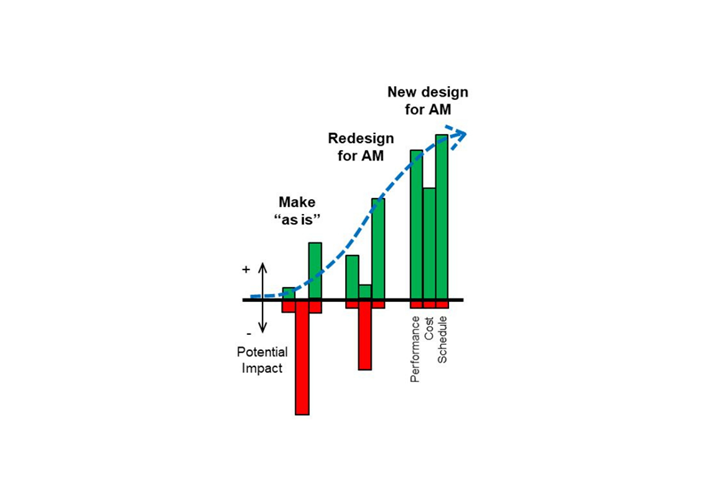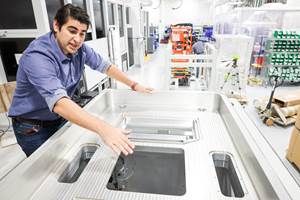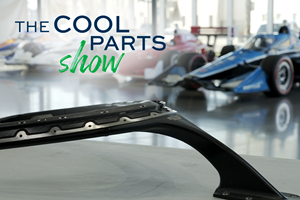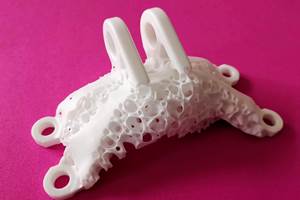Beginning the AM Journey: An Uphill Battle
Faster machines, cheaper feedstocks, new standards – with all of these advances, why is additive manufacturing still “an uphill battle” for so many?
Faster machines, cheaper feedstocks, new standards – with all of these advances, why is additive manufacturing (AM) still “an uphill battle” for so many? While many of the harsh realities of AM remain, if you have been keeping up with my column the past few months, you now have a much better understanding of how to chart your course and begin the AM journey. It won’t be easy, but by — and more importantly, through — design, you are in control of the value AM brings to your organization, not at the mercy of equipment providers or powder suppliers. Yes, they still control powder pricing and dictate your operating costs, but combining design’s dual role of adding value while avoiding costs is key to reaching that first peak and seeing new opportunities for AM that may be on the horizon.

Notional diagram of the potential impact of AM on performance, cost, and schedule as a company progresses on their journey. Photo Credit: Tim Simpson
So why the uphill battle? It largely happens because the tendency is to begin with AM as a process substitution, reproducing an existing part made via conventional means with AM. I have talked about this countless times before and may start sounding like a broken record, but now that we have a better understanding of the value of design, we can see why it is an uphill battle from the start. In short, the performance and cost benefits of AM are often in the red in the make “as is” case that often begins one’s AM journey. The only benefit at this first step is speed, which helps schedule — but it is for a part that has already been designed. So, shortening the product development cycle for an existing part doesn’t really help. “Doh!”, as my cartoon namesake would say. Trick then is to find situations where speed reduces lead-time (e.g., spares and repairs, say).
Only when you can start modifying a part for AM, or MfAM as I now call it (thanks David Dietrich and the team at Honeywell for introducing this to my attention!), can you start to gain traction with AM and begin the uphill climb. MfAM is a succinct way of avoiding the unwanted costs of AM that I discussed last month, and its application is just as important as the more exciting things that people talk about when designing for AM (e.g., topology optimization, lattice designs, biomimicry, and such) as I discussed two months ago. Unfortunately, you may not have the freedom to apply design for AM (DfAM) fully until you can “clean sheet” a new part or completely rethink an existing part for AM. Few established firms begin there, and they have to endure the earlier stages and chart an uphill course to maximize AM’s benefits.
It is the uncertainty around the potential upside of future parts designed for and made with AM that clouds this view, making the journey all the more difficult. Add the baggage one carries when basing the initial AM business case on process substitution that simply reproduces an existing part with AM, and you see why it is an uphill battle. The benefits often don’t add up, weighing you down from the start. Worse, it can derail the AM journey entirely as the costs add up.
But there is hope, as DfAM and MfAM are the “ying and yang” of a successful AM journey. DfAM drives value while MfAM avoids costs, and both are critical to making AM viable.
If you are redesigning a part for AM, then you begin with MfAM and apply DfAM to the best extent possible. Conversely, if you are designing a new part from scratch, then you begin with DfAM and apply MfAM to reduce costs. Not surprisingly, the end points from each of these endeavors is not the same, nor is the starting point. As such, the benefits differ as well. MfAM improves producibility and hence viability with AM, advancing you up the hill on your initial journey. As the path forward becomes clear, DfAM increases the benefits and helps you reach the peak. From there, the horizon comes into much better view, and you realize that fighting up the uphill battle is worth it as you look back on all that you have learned along the way.
Related Content
Seurat: Speed Is How AM Competes Against Machining, Casting, Forging
“We don’t ask for DFAM first,” says CEO. A new Boston-area additive manufacturing factory will deliver high-volume metal part production at unit costs beating conventional processes.
Read MoreThis 3D Printed Part Makes IndyCar Racing Safer: The Cool Parts Show #67
The top frame is a newer addition to Indycar vehicles, but one that has dramatically improved the safety of the sport. We look at the original component and its next generation in this episode of The Cool Parts Show.
Read More3D Printed Cutting Tool for Large Transmission Part: The Cool Parts Show Bonus
A boring tool that was once 30 kg challenged the performance of the machining center using it. The replacement tool is 11.5 kg, and more efficient as well, thanks to generative design.
Read MoreSpherene Creates Metamaterial with Geometry Derived from Spheres
An algorithm developed by Spherene Inc. generates Adaptive Density Minimal Surfaces (ADMS) as a self-supporting infill strategy that can be used to reduce mass and manage material properties in 3D printed parts.
Read MoreRead Next
3D Printed Polymer EOAT Increases Safety of Cobots
Contract manufacturer Anubis 3D applies polymer 3D printing processes to manufacture cobot tooling that is lightweight, smooth and safer for human interaction.
Read MoreCrushable Lattices: The Lightweight Structures That Will Protect an Interplanetary Payload
NASA uses laser powder bed fusion plus chemical etching to create the lattice forms engineered to keep Mars rocks safe during a crash landing on Earth.
Read MoreAlquist 3D Looks Toward a Carbon-Sequestering Future with 3D Printed Infrastructure
The Colorado startup aims to reduce the carbon footprint of new buildings, homes and city infrastructure with robotic 3D printing and a specialized geopolymer material.
Read More




















